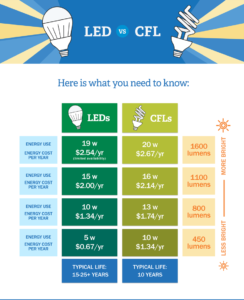Why Switching to LED Lighting is a Smart Business Move
2 min readThe Port Authority of New York and New Jersey (PANYNJ) is making major upgrades to the World Trade Center that will enhance the quality of lighting throughout the facility and save the transportation agency money. More than 13,000 lighting fixtures will be upgraded to high-efficient LED technology, reducing energy consumption and increasing the life expectancy of the lamps.
Following the implementation of these updates, the Port Authority is expected to save more than $715,000 in the first year with continued annual savings over a 10-year term. This project is expected to reduce carbon emissions by more than 4,700 metric tons, the equivalent of taking more than 1,000 passenger vehicles off the road, according to U.S. Environmental Protection Agency estimates, and will contribute to the Port Authority’s greenhouse gas emissions reduction goals.
Affordable compact fluorescent lamp (CFL) bulbs are often the go-to choice for facility managers, but they do not have the same long-term cost savings advantage that LED lighting offers. In addition to energy savings, there are many ways in which LED lighting trumps lighting from CFLs.
LED vs. Fluorescent Light Bulbs
LED bulbs produce light when an electrical current passes through them, making full light appear instantly. The process for lighting a CFL is a little more complicated and takes anywhere from 30 seconds to three minutes, which is why CFLs seem to take a while before they are fully lit.1
Here are some other differences to keep in mind when examining CFL vs LED bulbs:
- LEDs emit very little heat. In contrast, CFLs release about 80% of their energy as heat, according to Energy.gov. This affects the life span of the lightbulb; the higher the temperature, the shorter the useful life. LEDs tend to last for 15 to 25-plus years, whereas CFLs last up to 10 years.2
- Because LEDs emit light in a specific direction, they do not need diffusers or reflectors that trap lights. This helps increase LED efficiency for uses such as downlights common in hallways or bathrooms or task lighting.
- LEDs are more environmentally friendly. CFLs contain mercury and should be disposed of in a certain way, whereas LED lights do not have the same requirement.
- By choosing an LED bulb, you might pay half as much annually than if you were to use a CFL bulb. See the infographic below for more context.
Get started on making the switch to LED lighting and reap the environmental and financial benefits. LED lighting can reduce your carbon footprint and reduce your energy spend, offsetting the costs required to make the upgrades to your facility. Learn more.
Reference:
- https://blog.constellation.com/2016/03/25/led-vs-cfl-bulbs/?_ga=2.19380410.341077210.1539609975-600283820.1535558592
- http://www.nrdc.org/energy/lightbulbs/files/lightbulbguide.pdf

Source: http://www.nrdc.org/energy/lightbulbs/files/lightbulbguide.pdf

